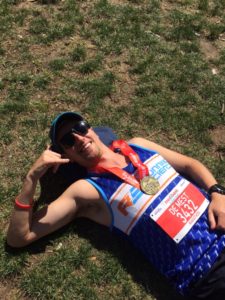
I’ve done a fair amount of running over the years, mainly Half Marathons and shorter. This was my first real crack at a Marathon and I chose Melbourne. What have I learnt? So much.
Firstly;
- Running is Awesome
The ‘runners high’ achieved from each session is awesome. The chemical release of Serotonin and Dopamine from running can help improve mood and even protect against mental health disorders. Ask any runner – crossing a finish line having achieved a PB is one of the great feelings.
- You Must Listen to your Body– not your training program (I’ve said this before here)
It’s easy to push through niggles and tell yourself it will go away. Making the decision to reduce the length or intensity of a sessions due to a niggle can save you from injury and much heartache down the track.
- Our Bodies can Adapt!
As long as we don’t exceed its capacity to adapt (That’s the hard part).
The thought of doing a 3 hour long training run used to scare me. It’s amazing how our bodies adapt, strengthen and increase its ability to tolerate higher running loads over time.
- You MUST manage your body
I’m talking about strength work, warm downs, foam rolling, running drills etc. Core work 10mins a day, Glute strength work a several times a week and endless ‘niggle management’. It can feel like a full time job! (Being a Sports Podiatrist does help:)).
I am lucky, I treat running injuries for a living I am able to diagnose and treat immediately. This leads to the ability to manage injuries while still training.
Not a health professional? Don’t despair, this is something you can learn too. It is crucial to know which injuries you can and cannot run through and importantly – how to manage them. An accurate diagnosis and treatment plan is key.
- Variety of Training Sessions is Key
There are many training programs available online. Some are great, some lack balance. Looking for a PB next time? The good programs have a mixture of Recovery Runs, Lactate Threshold and Lactate Tolerance sessions. These types of sessions commonly involve running at Race Pace and faster than Race Pace with appropriate recovery periods. They look to train your heart, lungs and legs for race day.
Finding a balance of these sessions to suit your current level of conditioning, time constraints and lifestyle is key.
- Rotate Footwear
I have touched on this recently in a blog on drop. Training for a Marathon requires multiple shoes. You can’t expect to do all your training and race in the one shoe – It will fatigue fast.
Vary the weight of the shoes. Heavier/stiffer shoes may suit long runs where we need a little protection, lighter/faster shoes will suit speed work where we need our feet to be engaged with the ground. This will lead to greater efficiency with your running.
- You must Track your Training
There are so many easy ways to do this – especially if you have a Sports watch.
I often look back through Strava history with an injured runner to see ‘spikes’ in training which has led to overload. Going back through your running history and identifying training errors can only be done if you track it.
And lastly;
- Marathon Training makes you skinny!
Many runners like this, my wife does not! I’ll put a few Kgs back on now the race is complete.
How did the race go? Awesome! 2hr48. It’s the BEST feeling and all worth it.

Happy Running – See you at the Balmain Fun Run.
Phil de Mestre, Sports Podiatrist
Running Science
